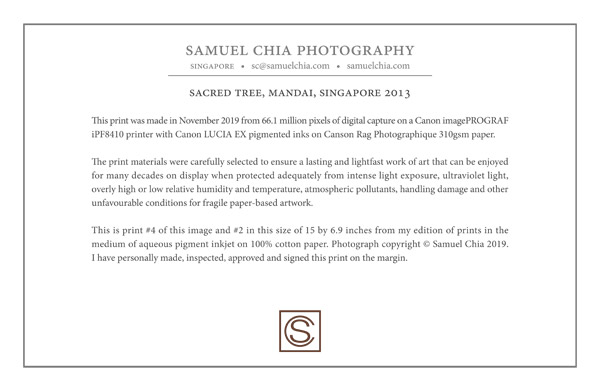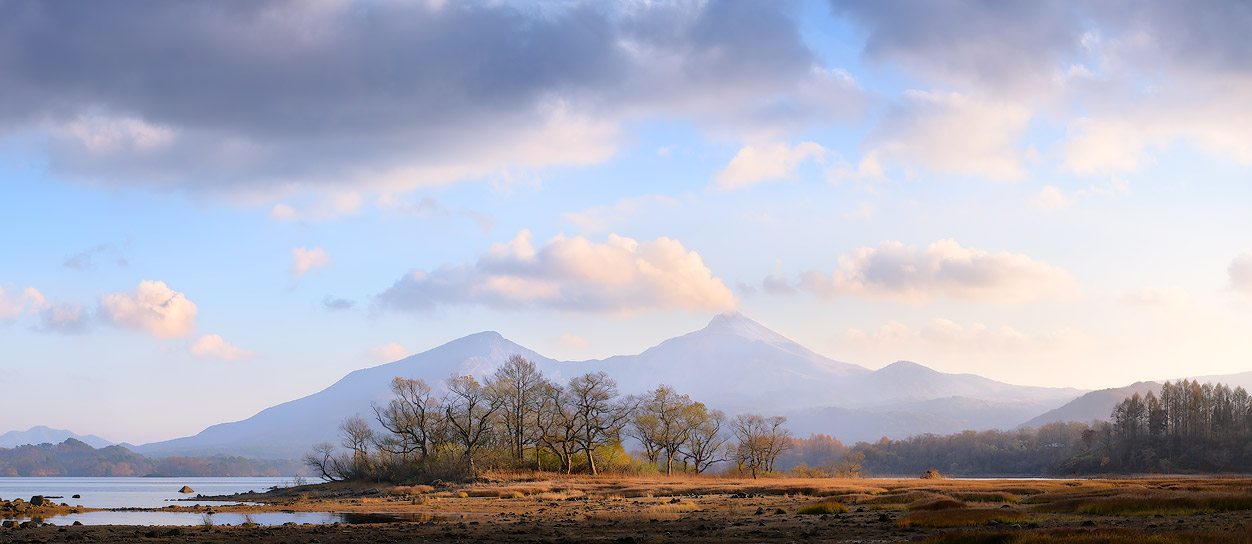Editions
All of my finely crafted prints are produced in numbered editions and each is issued with two numbers to indicate the chronological production position within the edition, defined by medium (such as aqueous pigment inkjet on cotton paper), and the number of prints of that particular size produced thus far. These are provided on a specially made label accompanying each print, which also contains vital provenance information. If the print is purchased framed, the label would come attached to the back of the frame. Here’s an example of such a label:

On the issue of “limited” editions:
Most photographs today are never printed at all and of those that are, most are never printed in as many copies as its edition size might indicate. Should a photograph turn out to be immensely popular, placing an artificial limit on prints serves only to deprive the photographer and the audience unfairly—musicians never had to place a limit on the number of times their music can be performed or you can listen to it. Artists have been known to issue a new “limited” edition run in a different size or different medium, a practice that is questionable at best. “Limited” editions also tend to be a convenient excuse for artificially raising prices of prints far more than they might be worth. I would caution any print buyer to think twice when they encounter so-called “limited” edition prints. Anything we can make is naturally limited in number. The sheer effort that each of my prints requires to produce and having little available time to make them at all, while maintaining very private access to even viewing them in the first instance, means few of my prints are actually in existence, more so than most “limited” editions. I do not and will not issue limited editions of my prints, which I find to be, by and large, a pretentious and misleading invention.

Care and Feeding of Prints
Aqueous pigment inkjet prints on cotton rag papers are extremely fragile, as are most paper-based artwork. Without adequate care for them, they will never last as long as they could, and this medium has proven to be extremely lightfast. Never touch a bare print directly; always wear a clean pair of cotton gloves. Always hold the print by the bare paper borders, never touching the printed area. Kinks and dents in paper are virtually impossible to remove perfectly, and scratches or scuff marks on the printed area are permanent damage. Be extremely cautious when unwrapping a bare print from its packaging, or better yet, just leave it to a trusted framer.
These prints are generally capable of withstanding about 100 megalux hours of exposure before subtle colour shifts become noticeable, although, without a pristine exact copy of the same print next to it, hardly anyone would be able to tell the difference. Ultraviolet light is (rightly) the most feared contributor to print fade, and indeed all precious artwork should be protected against it. But it isn’t the case that visible light is not damaging at all. The electromagnetic spectrum is a continuous one, so high-energy visible (blue especially) light is still capable of a significant amount of damage, as well as the radiant heat that comes from sunlight, even if filtered by UV protective glazing. You will double the number of years of lightfast display by simply reducing the illumination levels on the print to about half. I’ve also opted to relieve the print buyer entirely of concerns about fluorescing optical brightener dyes by simply choosing to print on papers that do not contain them at all, neither in the coating layers nor the base substrate.
And if you live in the tropics as I do, you would find that warmth and humidity are perhaps an even more dangerous enemy to your art collection than light exposure is in general, both helping to accelerate chemical processes that degrade the artwork. Mould and fungi can establish themselves in a matter of weeks. Atmospheric pollutants such as ozone and nitrous oxides can rapidly yellow these hydrophilic coated papers. Large changes in temperature and humidity also put physical stresses on paper-based artwork, which may cause warping or waviness within the frame or failures of any adhesives used. The solution to all of this is to protect the print in a well-made frame and hang it in a safe environment with a relatively stable temperature and relative humidity, ideally around 20-25 degrees C. and 40-55% RH.
Framing Guide
These are my framing recommendations.
Frame moulding
Wood or metal frames are both OK. In general, I prefer high-quality solid wood frames shown in their natural colour or stained to suit the palette of the print. If they do get scratched or dented, they can be mostly repaired while laminated wood frames cannot. Larger wood frames need an additional strainer frame and cross-bracing for structural strength. You may try to ask your framer for sustainably sourced wood frames. My favourite frame profile is about 2cm by 3cm in depth, with simple squared edges, an elegant look that flatters the photographic print. The edges of wood frames should ideally be isolated from the artwork with proper frame sealing tape, preventing outgassing and acetic acid from staining the edges of a print. Beware of outgassing of VOCs (volatile organic compounds) of various wood sealing and staining finishes, which can also damage your brain and organs. Recently, I’ve been introduced to Rubio Monocoat by following the methods of some woodworking craftsmen, but I don’t yet know of any framers using it.
Glazing
After experiencing the wonders of anti-reflective coatings first hand, I cannot recommend them more highly. For a relatively small additional expense, the visual clarity of the artwork is improved by an order of magnitude or more – you will never find a more dramatic difference with any other upgrade. Groglass Artglass AR 70 (AR 45 is also OK, but employs regular float glass and is thus somewhat less transparent and greener in tint) is ideal if you can ensure minimal UV exposure where you will hang the print. It remains the single, best, affordable glazing for framing. Groglass Artglass AR 99, at slightly higher cost and slightly lower transmission, will provide the added assurance that the glazing would absorb virtually all UV light. Do not bother with glazing that uses dichroic coatings to reflect UV light – they are essentially worthless for this purpose. For oversized pieces or if there is a risk of breakage (earthquakes, hospital, children), Tru Vue Optium Museum Acrylic or the new Artglass Acrylic UV 99 is ideal, at a significantly higher cost. I do not recommend framing without glazing, and methods that do so often come with their own issues.
Window Mat
Museum boards made by Rising, Bainbridge and Crescent are all OK. They are 100% cotton, alkaline-buffered mat boards. Rising is the only company that makes museum boards in gigantic sizes at the moment, but in 4-ply only. My preference is for an 8-ply Rising Museum Board cut with a reveal to show my signature on the bottom right of the print. Another interesting presentation method, free of adhesives and perhaps more contemporary in appearance, is to drop the window mat entirely, make the print with correctly proportioned margins and frame it directly against the glazing. Most framers will be against this based on traditional methods, but it will do no harm to my prints if done properly.
Base and Backing
The pursuit of visually flat prints without mounting them has led me to a unique solution. Do away with the base mat and Corflute/Foam-Cor backing. T-hinge the print directly to a 3mm sheet of opaque white or even clear acrylic. Any adhesives used must be an acid-free acrylic water-based type that is safe for artwork. Alternatively, I can, upon request, make most prints with a large enough paper border to match the dimensions of the outer cut of the window mat and backing so it can be sandwiched in between without any use of adhesives at all. The static of the acrylic sheet will hold the print flat and it is an ideal, inert and extremely strong backing material. This is my current preferred method when framed prints are purchased from me, and allows me to avoid needing to send prints for special cold mounting onto aluminium composite panel (every print of mine has been ruined by careless mounting workers in one way or another thus far). The back should be sealed with frame-sealing tape. This will help to further stabilise the artwork against external atmospheric fluctuations and also prevent insects and dust from entering the frame.
I can provide, upon request, a set of framing specifications and a to-scale illustration if you are ordering a bare print and opt to find your own professional framer to put it together. I include my recommendations on border widths for the window mat and reveal which are carefully proportioned to complement the dimensions of the print. The stresses of international shipping prevent me from shipping larger prints framed, and although I have had previous successes doing so with very elaborate packaging, charged accordingly, the risk is not worth bearing in most cases.